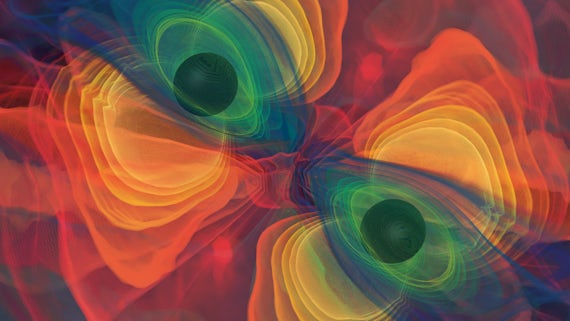Black hole binary searches
Mae'r cynnwys hwn ar gael yn Saesneg yn unig.
Our search for binary black holes helps us to gain greater knowledge of their formation processes, data on black hole populations and the distribution of their masses and spins.
On 14 September 2015, the two Laser Interferometer Gravitational Wave Observatory (LIGO) detectors picked up the first ever direct signature of gravitational waves - GW150914. Since then, three more signals from the merger of black holes, and a candidate signal, have been observed - LVT151012, GW151226, GW170104 and GW170814. This latter signal was also the first signal observed by the Virgo detector in conjunction with the two LIGO detectors.
From an observational point of view, gravitational waves are the best probes of black holes. Detection of gravitational waves from a black hole binary merger would mark an unambiguous observation of both a black hole, and a black hole binary.
Subsequent detections will give us first hand data on galactic black-hole populations, along with the distribution of their masses and spins – key information that is currently missing from models of stellar evolution and galaxy formation.
The potential scientific payoff from observations of black hole binaries is, therefore, enormous.
Our research
Over the coming years, the advanced LIGO and the Virgo detectors will be taking data at ever increasing sensitivity. We will work with other groups in the LIGO scientific collaboration to perform a search for these signals in the advanced detector data.
Advanced detectors will be sensitive to black-hole binaries of total mass between 6 and 400 solar masses, with a distance reach up to 7.7 Gpc, and can hence study demographics of stellar and intermediate mass black hole populations at cosmological distances.
Measurements of their masses and spins will yield insights into the formation processes of black holes through supernovae. Observation of high mass black holes will also challenge current stellar formation and evolution theories. Rare high signal-to-noise ratio events will help test general relativity beyond the quadrupole formula and in the strong field regime that is not accessible in solar system experiments or radio binary pulsars observations.
The search for binary black holes
We have worked to develop a search pipeline capable of extracting black hole binary signals from gravitational wave data taken by the LIGO and Virgo detectors.
The LIGO S5 and S6 data and Virgo VSR2 and 3 data has been searched for these signals. More importantly, this was the first time ever that an upper limit was obtained for a population of binary black holes in which black holes had spins (aligned with the orbital angular momentum).
Great progress has been made in extracting source parameters from the observed signal, including pioneering the implementation of the nested sampling algorithm for Bayesian inference and using Bayesian model selection to assess how well future observations of binary black holes will test the 'no- hair' theorem. We have also investigated degeneracies in spin-aligned models that limit the ability to measure the mass ratio and total spin of the system.
In the process of modelling the ringdown waveforms we discovered a previously unknown effect that has provided us a new insight on how deformed black holes settle down to their quiescent stationary state. Gravitational waves emitted in the merger phase consist of a superposition of damped sinusoidal oscillations called quasi-normal modes.
Until recently, we did not know which modes were excited when a binary merges to form a single deformed black hole or the relationship between the
amplitude of the different modes and the masses and spins of the progenitor binary. We found the remarkable result that certain modes carried information about progenitor spins while others depended almost entirely on the mass ratio of the progenitor black holes. Thus observation of the ringdown signal alone could tell us about the properties of the progenitors
The search for binary black holes in Advanced detector data
Our other research focuses on the development, enhancement and deployment of a search for binary black holes in the advanced detector data.
The search makes use of much of the same infrastructure as is being developed for the neutron star binary search. However, there are additional challenges to be faced in black hole binary searches, in particular the need to make use of full waveform models that incorporate merger and ringdown in the waveform, account for the effects of black hole spin on the binary evolution and include the higher signal harmonics of the waveform.
We will also investigate the ramifications of black hole binary observations, and prepare tools to accurately extract parameters and make inferences about their populations.
LIGO scientists detect gravitational wave signal from the merging of two black holes.


